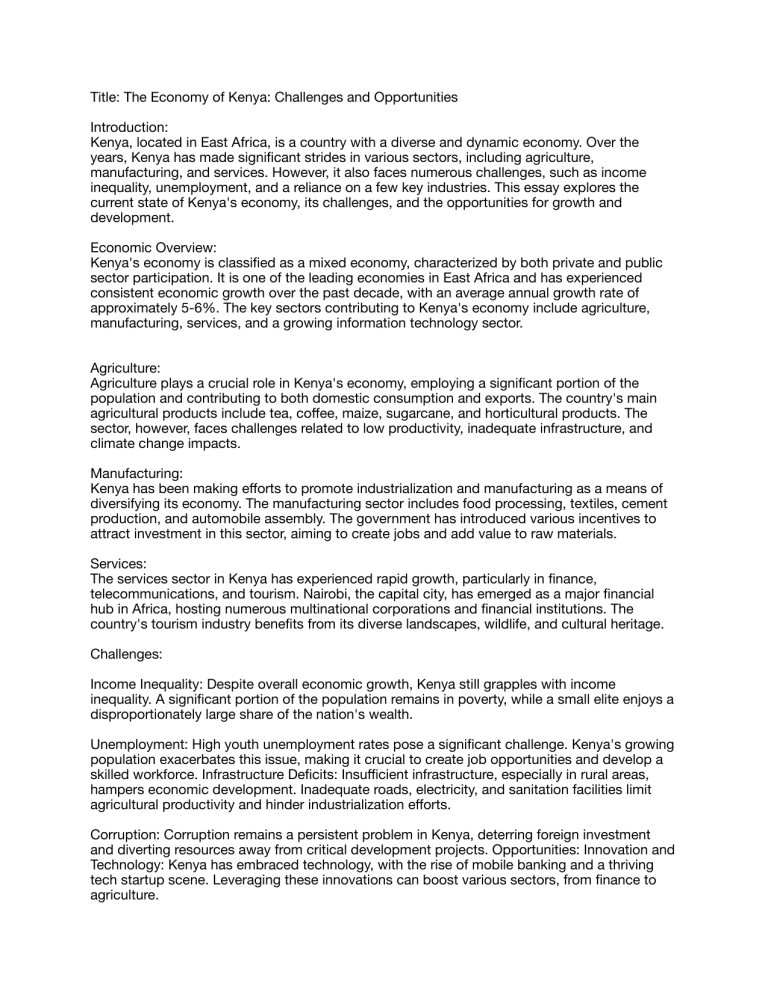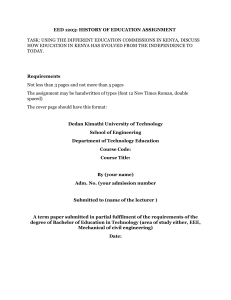
Title: The Economy of Kenya: Challenges and Opportunities Introduction: Kenya, located in East Africa, is a country with a diverse and dynamic economy. Over the years, Kenya has made signi cant strides in various sectors, including agriculture, manufacturing, and services. However, it also faces numerous challenges, such as income inequality, unemployment, and a reliance on a few key industries. This essay explores the current state of Kenya's economy, its challenges, and the opportunities for growth and development. Economic Overview: Kenya's economy is classi ed as a mixed economy, characterized by both private and public sector participation. It is one of the leading economies in East Africa and has experienced consistent economic growth over the past decade, with an average annual growth rate of approximately 5-6%. The key sectors contributing to Kenya's economy include agriculture, manufacturing, services, and a growing information technology sector. Agriculture: Agriculture plays a crucial role in Kenya's economy, employing a signi cant portion of the population and contributing to both domestic consumption and exports. The country's main agricultural products include tea, co ee, maize, sugarcane, and horticultural products. The sector, however, faces challenges related to low productivity, inadequate infrastructure, and climate change impacts. Manufacturing: Kenya has been making e orts to promote industrialization and manufacturing as a means of diversifying its economy. The manufacturing sector includes food processing, textiles, cement production, and automobile assembly. The government has introduced various incentives to attract investment in this sector, aiming to create jobs and add value to raw materials. Services: The services sector in Kenya has experienced rapid growth, particularly in nance, telecommunications, and tourism. Nairobi, the capital city, has emerged as a major nancial hub in Africa, hosting numerous multinational corporations and nancial institutions. The country's tourism industry bene ts from its diverse landscapes, wildlife, and cultural heritage. Challenges: Income Inequality: Despite overall economic growth, Kenya still grapples with income inequality. A signi cant portion of the population remains in poverty, while a small elite enjoys a disproportionately large share of the nation's wealth. Unemployment: High youth unemployment rates pose a signi cant challenge. Kenya's growing population exacerbates this issue, making it crucial to create job opportunities and develop a skilled workforce. Infrastructure De cits: Insu cient infrastructure, especially in rural areas, hampers economic development. Inadequate roads, electricity, and sanitation facilities limit agricultural productivity and hinder industrialization e orts. fi fi fi fi fi fi ff ffi ff fi fi fi fi ff fi Corruption: Corruption remains a persistent problem in Kenya, deterring foreign investment and diverting resources away from critical development projects. Opportunities: Innovation and Technology: Kenya has embraced technology, with the rise of mobile banking and a thriving tech startup scene. Leveraging these innovations can boost various sectors, from nance to agriculture. Regional Trade: Kenya is strategically positioned to bene t from regional trade agreements, such as the East African Community (EAC) and the African Continental Free Trade Area (AfCFTA). Enhanced trade can stimulate economic growth and job creation. Agriculture Modernization: Investing in modern agricultural practices, irrigation, and post-harvest management can increase productivity, reduce food insecurity, and improve rural livelihoods. Sustainable Tourism: Kenya's unique natural and cultural heritage provides opportunities for sustainable tourism development, contributing to economic growth while preserving the environment and local cultures. fi fi Conclusion: Kenya's economy presents a mixed picture of progress and challenges. While the country has experienced consistent economic growth, it must address issues like income inequality, unemployment, and corruption to ensure that the bene ts of growth are distributed more equitably. Leveraging technological innovation, regional trade agreements, and sustainable development strategies can help Kenya overcome these challenges and achieve long-term economic prosperity. By diversifying its economy and addressing structural issues, Kenya can continue its journey toward becoming a more vibrant and inclusive economy in East Africa.




